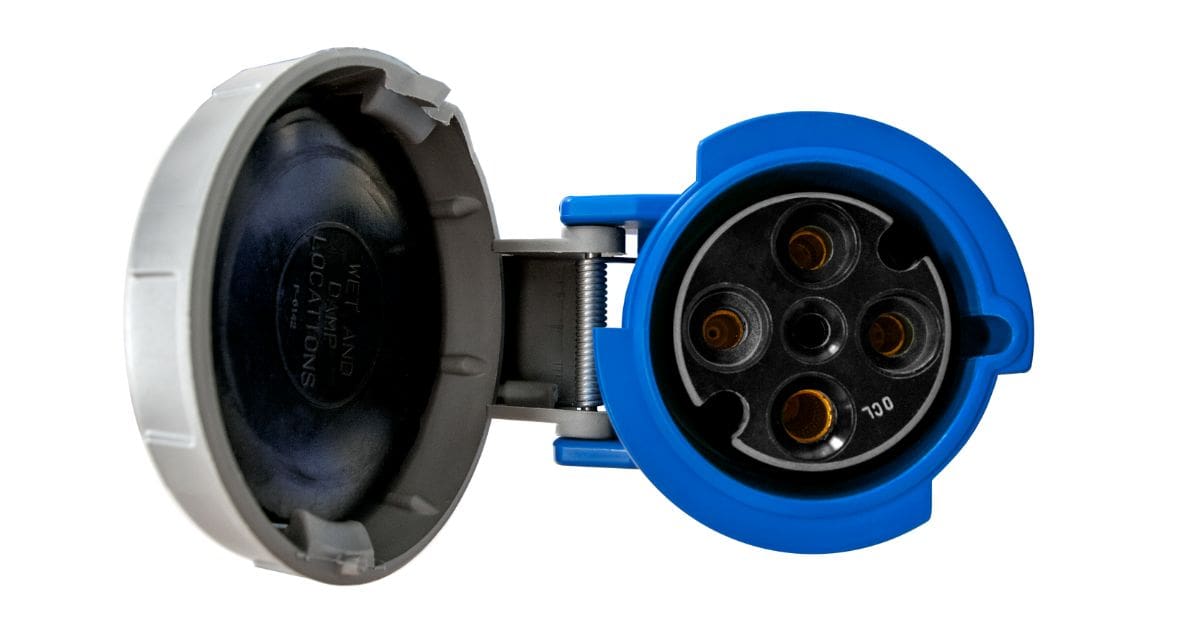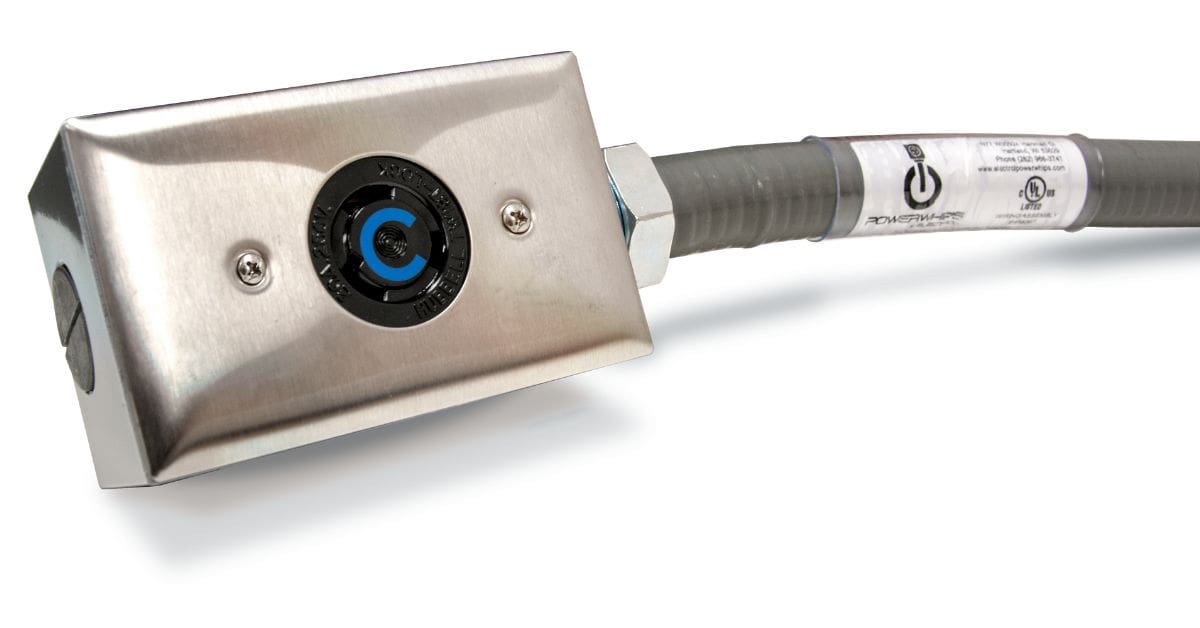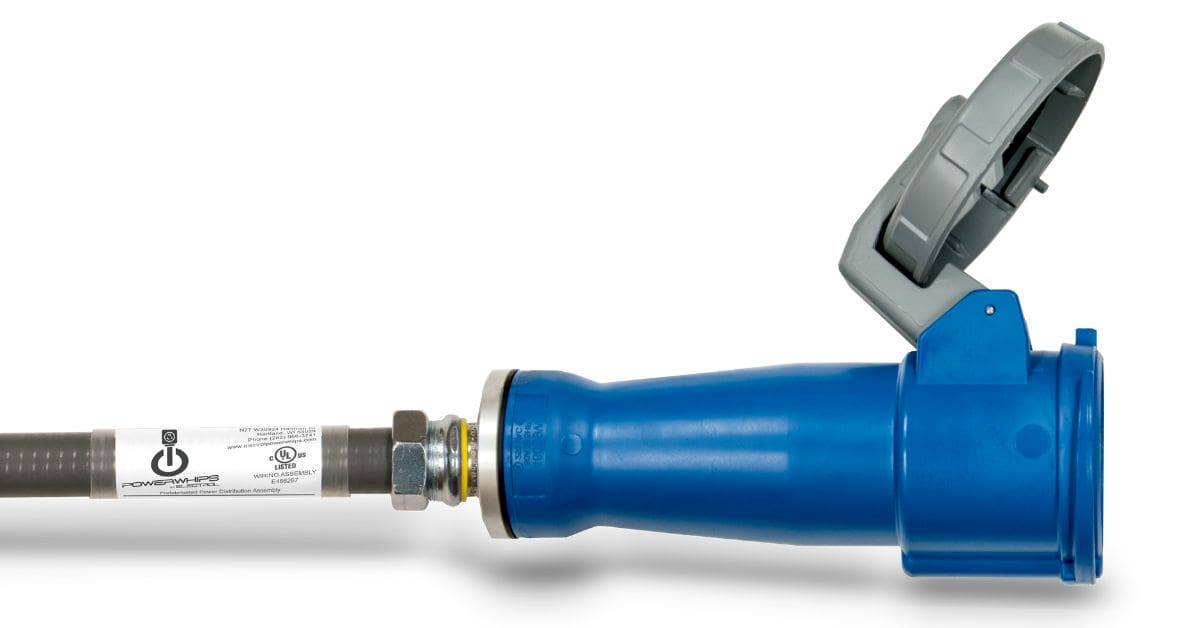
Modern data centers serve as the backbone of AI infrastructure, enabling the heavy computational workloads that drive artificial intelligence. It’s critical to employ well-designed power distribution systems to support these workloads.
One component that is often overlooked in data centers is the power whip. These cables connect server racks to power distribution units or PDUs, delivering reliable electricity for the operation. Read along to learn what power whips are and why data centers need them for AI workloads.
What Is a Data Center Power Whip?
A data center electrical power whip transmits electrical power from a remote power panel to a PDU which then distributes power to equipment in data center racks. Data center power whips act as a critical final link in the power distribution chain, connecting power to PDUs which directly supply power to the IT equipment.
The primary function of a power whip is to ensure the safe and efficient delivery of consistent electricity to PDU’s, making power whips indispensable in environments like AI data centers that demand high uptime and optimized power management.
Types of Power Whips
There are several types of power whips, and choosing the correct one can significantly improve safety and efficiency within data centers. Selecting the appropriate power whip ensures optimal performance by aligning with your operational needs and infrastructure requirements. Below, we will take a closer look at the various types of power whips and their benefits so you can select the ideal solution for your infrastructure.
Liquid-Tight Flexible Material Conduit Cables
Liquid-tight flexible material conduit (LMFC) cables are expertly designed to handle extreme environments and ensure reliable performance. These power whips incorporate a flexible metal core surrounded by a durable, liquid-tight, and flexible material, offering exceptional protection against water, oil, and corrosive substances.
Thanks to their high moisture and corrosion resistance, these cables can withstand heavy mechanical stress and safeguard electrical wiring from exposure to moisture.
Flexible Metal Conduits
Flexible metal conduits (FMC) use helically wound metal strips, enabling them to maneuver through various structures with ease. Their flexibility allows them to bend and adapt to tight spaces, making them ideal for challenging layouts without sacrificing performance. Additionally, these conduits minimize the risk of mechanical damage and provide significantly greater strength than nonmetallic alternatives.
SO Cords
Service, oil-resistant, and weather-resistant cords, otherwise known as SO or SOOW cords, deliver exceptional performance in demanding environments. These flexible power cables are highly regarded for their durability, thanks to their thermoset rubber insulation that effectively protects the cord from damage caused by external factors.
Additionally, their heat-resistant properties make them ideal for applications requiring frequent movement and high mobility. Engineered for reliability, SOOW cords excel in protecting electrical systems from wear and tear, ensuring consistent performance in various industrial and commercial settings.
Tray Cables
Tray cables provide versatile solutions for installation in cable trays, conduits, or exposed environments. Known for their durability, these cables efficiently handle heavy-duty workloads while offering flexible configurations to support various voltage requirements. Equipped with flame-resistant jackets, they enhance safety and are approved for a wide range of indoor and outdoor applications, including AI data centers that demand reliable performance and protection.

Why Data Centers Need Power Whips for AI Workloads
AI data centers face unique challenges when it comes to power distribution. The heavy computational requirements of AI workloads place immense stress on hardware components such as graphics processing units (GPUs), tensor processing units (TPUs), and storage arrays.
To support these systems, data centers must implement reliable power delivery strategies that can protect against failures and maintain consistent energy flow.
AI Hardware Requires Extensive Power
AI hardware, including GPUs and accelerators, demands substantially higher power consumption than traditional servers. A single AI-enabled server typically uses between 1.5 and 5 kW of power, far exceeding the energy needs of standard servers. Reliable power whips play a vital role in safely and efficiently delivering the necessary wattage for elevated power requirements.
These power whips are designed to support the constant energy flow needed for advanced AI systems, ensuring seamless compatibility and minimizing risks associated with high power loads. By providing dependable power delivery, they optimize performance and maintain the stability of critical AI infrastructure, which is essential for managing large-scale data processing tasks.
Intensive Cooling Needs
AI workloads generate significantly more heat than traditional server racks, creating a demand for enhanced cooling solutions. Cooling equipment, such as computer room air conditioning (CRAC) units, depends heavily on power sources delivered through reliable power whips. Power whips ensure a continuous energy supply that keeps cooling systems operational.
Power whip failure can compromise cooling equipment and damage expensive AI hardware. To mitigate such risks, AI data centers must prioritize durable and resilient power delivery systems that safeguard cooling operations.
Demanding Data Management
Aside from power and cooling needs, AI applications also demand rigorous data management and storage. Training and running large AI models involves managing vast datasets, often spanning petabytes in size. Accessing and transferring this data from storage systems to processing units requires continuous, high-speed movement.
A reliable power infrastructure, including durable power whips, is critical for supporting these high-intensity data processes. When a power whip fails, it can result in data corruption and operational disruptions of AI workloads.
The Rapidly Evolving AI Industry
The AI landscape continues to evolve rapidly, with groundbreaking hardware and software emerging at every turn. Beyond the massive power demands associated with AI workloads, planning and implementing scalable infrastructure has become a priority to accommodate these rapid advancements.
Power whips are known for their flexibility and durability, and they play an essential role in supporting modular and scalable setups. These electrical conduits are engineered to adapt seamlessly to shifting rack configurations and surging power consumption requirements. They enable data centers to remain agile and prepared for the demands of the growing AI industry.

A Reliable and Consistent Solution
AI development demands high power consumption and reliability. Data centers must prioritize reliable power distribution systems to support AI workloads, and power whips are critical components.
Investing in high-quality power whips solidifies your data center’s ability to handle the demands of AI-driven applications. It also positions your organization to thrive in the competitive landscape of artificial intelligence.
Are you looking to optimize your data center for AI? Look no further than Electrol Powerwhips. We offer top-tier, heavy-duty, and durable electrical whips tailored to fit your unique infrastructure needs.
